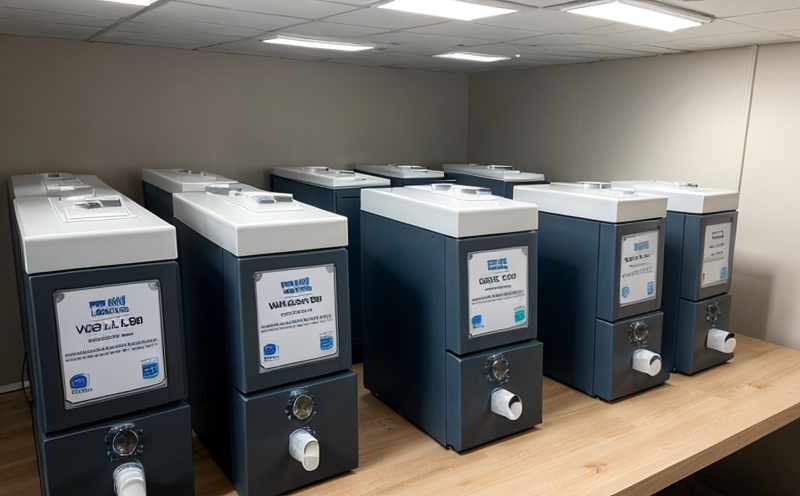EN 717-1 Wood based panels Formaldehyde release Chamber method
The European Standard EN 717-1 specifies the formaldehyde release from wood-based panels in a temperature-controlled chamber. This method is critical for ensuring compliance with environmental regulations and quality standards, particularly relevant to sectors like construction, furniture manufacturing, and interior design.
This testing procedure involves placing specimens of wood-based panels into a climate-controlled chamber where they are exposed to a constant temperature and humidity level over an extended period. The formaldehyde released from the panel is quantified using gas chromatography or other approved analytical methods. The standard aims to ensure that products meet stringent limits on formaldehyde emissions, which can have significant health impacts if inhaled.
The testing process begins with careful preparation of specimens according to predefined dimensions and weight requirements. Ensuring accurate specimen preparation is crucial as it directly influences the test results' reliability. After conditioning the specimens under specified humidity and temperature conditions, they are placed into a climate-controlled chamber for the duration required by the standard.
During this exposure period, sensors continuously monitor the formaldehyde concentration inside the chamber. Once the exposure time ends, the specimen is removed from the chamber, and the remaining formaldehyde is measured using appropriate analytical techniques. The results are then compared against the specified limits set forth in EN 717-1 to determine compliance.
For accurate testing, it's essential to use calibrated equipment that adheres strictly to the prescribed standards. Compliance with these standards ensures consistent and reliable test results across different laboratories, enhancing confidence in the final product's quality and safety.
- Calibration: Ensuring all instruments used are regularly calibrated to maintain accuracy.
- Environmental Control: Maintaining precise temperature and humidity levels within the chamber throughout the testing period.
The EN 717-1 method is widely recognized for its robustness in assessing formaldehyde emissions, making it a cornerstone of compliance programs aimed at reducing indoor air pollution from wood-based products. By adhering to this standard, manufacturers can ensure their products meet stringent safety and quality requirements.
Scope and Methodology
The scope of the EN 717-1 method includes determining the formaldehyde release from wood-based panels into a controlled environment. This test is crucial for ensuring that products comply with environmental regulations, particularly in sectors such as construction, furniture manufacturing, and interior design.
- Test Specimens: The standard specifies the dimensions and weight of specimens to be tested, which are typically cut from the panels using a specified cutter. These samples should represent the typical use conditions for the final product.
- Chamber Setup: A climate-controlled chamber is used where the test specimens are placed. This setup ensures that the environmental conditions remain constant throughout the testing period.
The methodology involves several key steps, including:
- Preparation of test specimens according to the specified dimensions and weight requirements.
- Conditioning the specimens under specific humidity and temperature conditions for a set duration before placing them into the chamber.
- Exposing the specimens to controlled temperature and humidity levels within the chamber for an extended period, during which formaldehyde release is monitored continuously.
- Removing the specimen from the chamber at the end of the exposure time and measuring any remaining formaldehyde using approved analytical techniques.
The results obtained are then compared against the specified limits in EN 717-1 to determine compliance. This method ensures that the products meet stringent safety and quality standards, enhancing consumer confidence in wood-based panel products.
Quality and Reliability Assurance
Ensuring high-quality results in formaldehyde release testing is paramount for maintaining product integrity and compliance with international standards. Here are some key measures that laboratories take to ensure the reliability of their test results:
- Certification: Regular calibration and validation of instruments used in testing against national or international standards.
- Standard Operating Procedures (SOPs): Strict adherence to established procedures for specimen preparation, chamber setup, and data recording.
- Data Validation: Cross-checking results with independent laboratories using the same methods to ensure consistency.
- Training: Continuous training of laboratory personnel on the latest techniques and best practices in formaldehyde release testing.
By implementing these measures, laboratories can provide accurate and reliable test results that are trusted by industries worldwide. Regular audits and quality assurance checks further enhance the reliability of the testing process.
International Acceptance and Recognition
The EN 717-1 method is widely recognized internationally for its stringent approach to assessing formaldehyde emissions from wood-based panels. Its acceptance in various countries underscores its significance as a benchmark for quality assurance:
- European Union: EN 717-1 is the standard adopted across the EU, ensuring consistent compliance with environmental regulations.
- United States: While not mandatory, many U.S. manufacturers and importers voluntarily comply to meet international standards and enhance product quality.
- Asia-Pacific Region: Several countries in this region also reference EN 717-1 for its robust testing protocols.
The widespread acceptance of this method reflects its reliability and effectiveness. Compliance with EN 717-1 is often seen as a demonstration of a company's commitment to environmental responsibility and product safety, which can enhance brand reputation and marketability.





